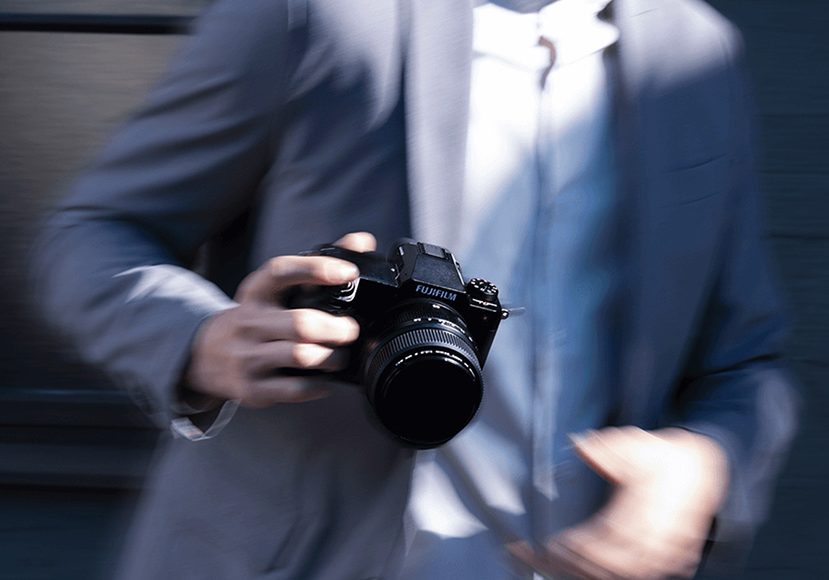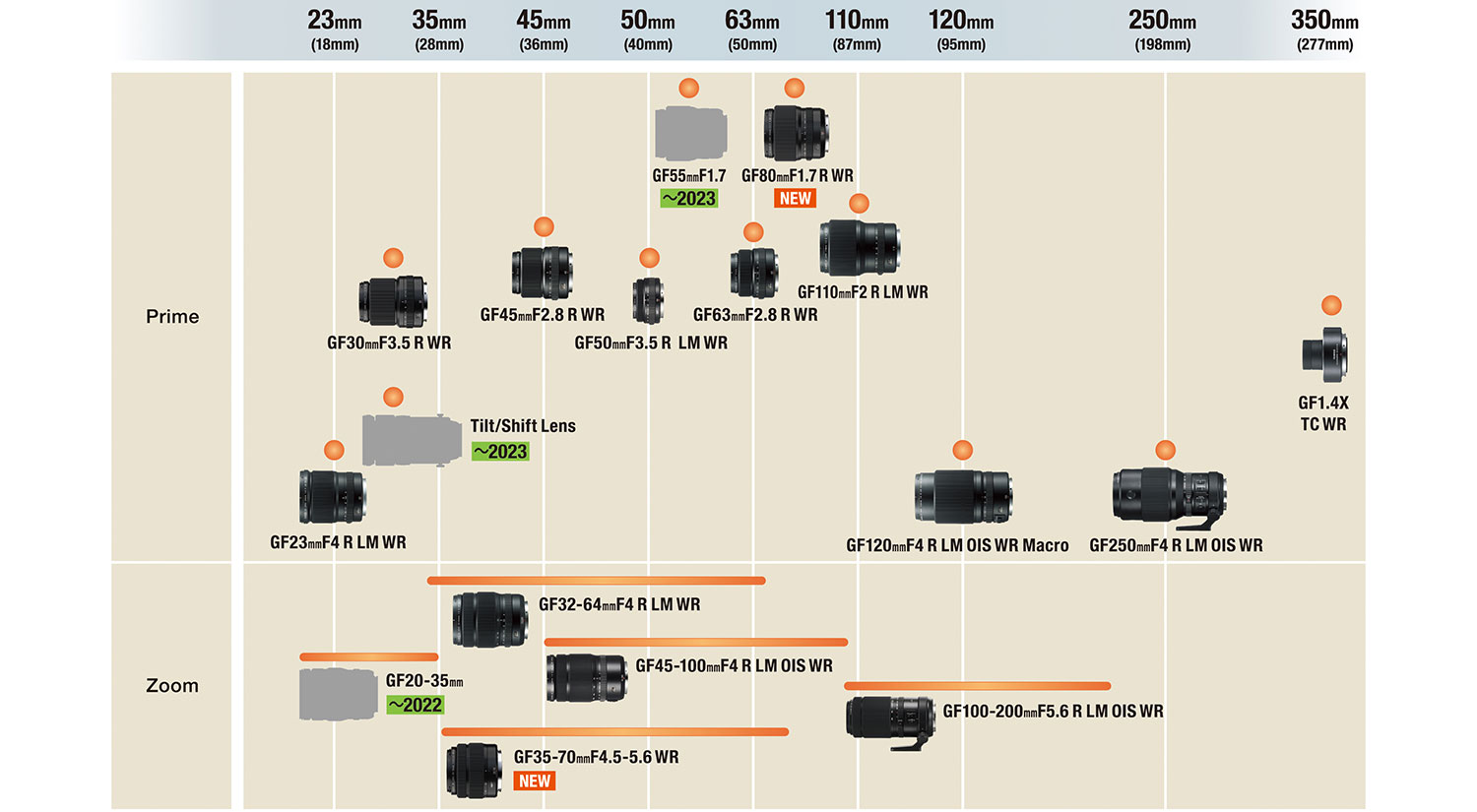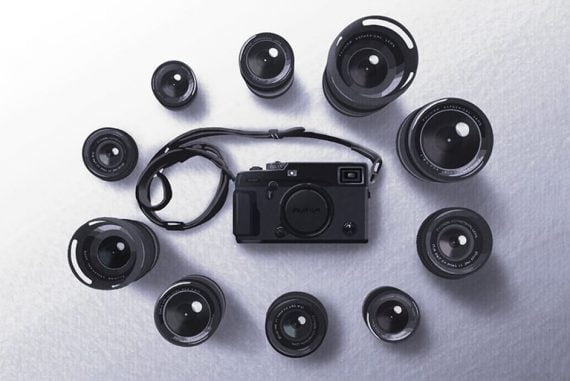
Best Lenses for Fujifilm GFX 100s in 2023
With 102 megapixels to play with, the GFX100s deserves the best glass availbale. Fortunately, Fujifilm came up with the goods. Here's the lowdown.
The Fujifilm GFX 100s is Fujifilm’s flagship medium format camera.
It’s a beast. One for the professionals or wannabe professionals with money to burn.
It’s an image-creating powerhouse, and to get the most out of it, you need to complement it with the best medium format lenses on the market.

Superb image quality, fast and accurate autofocus, and a robust weather-resistant design makes this our favourite lens for the GFX 100s.
You already know that Fujifilm makes some amazing lenses for its X-Mount cameras.
Fortunately, this is also true for the G-Mount, with some incredible glass available in a range of focal lengths.
This article will take you through some of the options for different styles of photography, and give you a good overview of the best lenses for Fujifilm GFX 100s.
Table of Contents
What Are the Best Lenses for Fujifilm GFX 100s in 2023?
| Image | Product | Features | |
|---|---|---|---|
 | Fujinon GF 110mm f/2 R LM WRBEST PORTRAIT LENS |
| Check AMAZON Price → Check B&H Price → |
 | Fujinon GF 23mm f/4 R LM WRBEST WIDE-ANGLE PRIME LENS |
| Check AMAZON Price → Check B&H Price → |
 | Fujinon GF 50mm f/3.5 R LM WRBEST WALK-AROUND LENS |
| Check AMAZON Price → Check B&H Price → |
 | Fujinon GF 80mm f/1.7 R WRBEST FAST PRIME |
| Check AMAZON Price → Check B&H Price → |
 | Fujinon GF 32-64mm F/4 R LM WRBEST WIDE-ANGLE ZOOM |
| Check AMAZON Price → Check B&H Price → |
 | Fujinon GF 250mm f/4 R LM POS WRBEST TELEPHOTO PRIME LENS |
| Check B&H Price → |
 | Fujinon GF 100-200mm f/5.6 R LM OIS WRBEST TELEPHOTO ZOOM LENS |
| Check AMAZON Price → Check B&H Price → |
 | Fujinon GF 120mm f/4 Macro R LM OIS WRBEST MACRO LENS |
| Check AMAZON Price → Check B&H Price → |
 | Fujinon GF 45-100 f/4 R LM OIS WRMOST VERSATILE ZOOM |
| Check AMAZON Price → Check B&H Price → |
Fujinon GF 110mm f/2 R LM WR (Best Portrait Lens)
- Weather-sealed
- Quick, reliable linear autofocus
- Great image quality
- Close to zero chromatic aberration even in extreme conditions
- Heavy, over 1000g
- Minimum focus range of 1 metre
The Fujinon GF 110mm is a fantastic portrait lens.
Its focal length makes it ideal for photographing full-body shots or close-ups. It allows you to stay close enough to your subject to communicate with them and won’t warp their features in the way a wider lens often can.
With its large aperture, it’s great in low-light conditions and gives you complete control over a range of depths of field. You can also create beautiful bokeh in the foreground and/or the background.
As befitting one of the most expensive lenses Fuji makes, it’s made of high-quality material and feels great to use.
The attention to detail is also second to none. The manual focusing ring and aperture selection ring have different resistances to them and are made of different materials (not often the case with lesser lenses), so you can easily find them without looking.
Overall, a professional lens for professional portrait photographers.
Fujinon GF 23mm f/4 R LM WR (Best Wide-Angle Prime Lens)
- Very little distortion for an ultra-wide lens
- Very sharp images
- Build and design quality
- No in-lens image stabilisation
- F4 could be limiting for some use cases
This is Fuji’s super-wide offering.
Definitely not for portraits, like the one above, but still a specialist lens.
It has a focal length equivalent to 18mm in 35mm format, so you can really fill the frame with a lot of landscape detail.
And this is one of the styles this lens is ideal for – landscapes. You often need a wide-angle lens to fit everything in. As such it’s also ideal for shooting other large objects or scenes such as architecture and interiors.
Similar to the 110mm, it’s also completely weather-sealed, so you’ll have no worries about using it outside in relatively harsh conditions. And it has the same quality of design, build and autofocus capabilities.
The images are sharp, sharp, sharp, all the way to the edges; vital when you’re photographing the things this lens was built for.
Fujinon GF 50mm f/3.5 R LM WR (Best Walk-Around Lens)
- Very small and light
- Unobtrusive
- Great image quality
- None
50mm is one of the best focal lengths for all-round photography, such as street or travel photography.
This is the sweet spot between a wide-angle lens and a mid-zoom – still giving you enough room to capture landscapes or urban scenes (as long as you’re not too close to them) but also a perfect length for portraits and detail shots.
The optical quality of the GF 50mm f/3.5 lens is great. It gives you crisp, clear images all the way to the edges of the frame, even when wide open.
It’s the most compact lens Fuji offer for their GFX system, so an ideal option for anyone who wants to minimize the size of the equipment they’re carrying around while still maintaining flexibility in terms of what they can photograph.
Since the GFX 100s is a rather chunky camera, it feels great to have such a compact lens attached to it.
And as with all Fuji lenses that contain ‘WR’ in the title, this one’s also weather resistant.
Fujinon GF 80mm f/1.7 R WR (Best Fast Prime)
- Sharp image quality
- Great low-light performance
- High-quality design
- Manual focus can be slow
- Chromatic aberration and fringing
- No linear motor, so autofocus can be loud
The Fujinon GF 80mm f/1.7 has one of the widest apertures for medium format cameras on the market. This lens is super-fast!
Shooting in low-light conditions will be a breeze, and also taking portraits. The wide aperture and 80mm focal length give you great flexibility in terms of your creative choices.
If you’re photographing people you won’t be so far away that you’ll be unable to communicate with them.
Shot wide open at f/1.7 produces some beautiful bokeh, enhanced by the stellar image quality of the GFX 100s.
Fujinon GF 32-64mm F/4 R LM WR (Best Wide-Angle Zoom)
- Linear motor autofocus
- Well-defined image quality and colours
- Robust build
- Relatively heavy
- Range of focal lengths could be limiting
- Significant overlap with the 45-100mm
As a ‘standard’ lens, this piece of equipment is meant more for photographers starting out with the GFX system.
It’s a good everyday shooting option. The lens will give you the speed and the focal lengths to comfortably shoot street photography, travel images, detail shots and portraits.
One helpful feature is the aperture ring’s button that allows you to switch the aperture selection from the lens to the body.
And this 32-64mm has the linear autofocus motor – same as the flagship lenses – which makes focusing smooth and quiet.
Some photographers may feel the 32-64mm zoom range a little odd at first, but will quickly become familiar.
Fujinon GF 45-100 f/4 R LM OIS WR (Most Versatile Zoom)
- Image stabilization
- Rugged design
- Fast, quiet autofocus
- Awesome image sharpness and definition
- Heavy, over 1000g
- Significant overlap with the 32-63mm
This offering will give GFX 100s shooters great flexibility.
It’s a robust lens with image stabilization. Given its size, you’ll get your best results shooting with a tripod, but it’s also very capable of giving you sharp, high-definition shots when shooting hand-held, even wide open.
Like the 32-64mm lens, it’s a good all-purpose option. The 45-100 mm focal lengths will allow you to photograph street scenes and landscapes – basically whatever you want to shoot when you head out with your camera.
It will also enable you to shoot fantastic portraits, and as it’s f/4, it’ll still give you a nice creative edge to either completely blur out the background and foreground or use it in low light.
Fujinon GF 250mm f/4 R LM POS WR (Best Telephoto Prime Lens)
- Image stabilization
- Fast autofocus
- Autofocus preset buttons
- Excellent contrast and sharpness
- Heavy, almost 1.5kg
For photographers shooting wildlife, corporate events, weddings, or portraits, this is a great piece of photography equipment.
Its aperture is ideal for separating subjects from their background and also performs well in low-light situations.
It’s not a light lens, but that’s to be expected. It’s packed with glass and features such as image stabilization and autofocus preset buttons so that you can switch between modes lightning-fast, according to your needs.
For example, set up one mode for single-point autofocus, another for tracking moving objects, and so on.
The build and design quality is top-notch, as you’d expect from one of Fujifilm’s flagship models, and the image quality is too. Sharp, with good contrast, and the colours are rendered perfectly.
Fujinon GF 100-200mm f/5.6 R LM OIS WR (Best Telephoto Zoom Lens)
- Image stabilization helps with handheld shooting
- Great for shooting events
- Robust build, weather resistant
- Slow aperture and limited range
- Minor vignetting when shooting wide open
This 100-200mm lens could be a good daytime event or walkabout lens.
You could shoot portraits with it, urban scenes, anything, as long as you are not intending to stand too close to whatever it is you want to photograph.
Bear in mind, though, that with an aperture of f/5.6, this is not a particularly fast lens. Although using it with the GFX 100 will probably still allow you to use it in low light, you won’t get the same performance as you would out of an f/4 or lower.
That being said, the images you’ll get from this lens, especially when there’s good ambient light, will still be of excellent quality.
The OIS (Optical Image Stabilization system) helps when shooting at slower shutter speeds or in low light, meaning that you don’t need to rely on the high ISO performance of the GFX 100s as much.
Fujinon GF 120mm f/4 Macro R LM OIS WR (Best Macro Lens)
- 5 stops of image stabilization
- Focus range limiter aids speed
- Smooth operation for video
- Not fully image stabilized
- Not true 1:1 macro
- Pretty heavy – close to 1.5 kg
Macro lenses are great for anyone wanting to shoot anything that requires getting really close to the subject. Product photographers use them, and so do wildlife photographers when shooting smaller animals or insects.
They can also be used in a non-macro capacity to shoot portraits.
This macro lens can do all of those things, all housed in a structure with the build and design quality that is a hallmark of the Fuji GFX system lenses.
It’s heavy, though, and although it has Fuji’s OIS image stabilization through some of its focal lengths, you’d best use a tripod with a tripod collar to protect your GFX 100’s lens mount.
Fujifilm G-Mount Lens Roadmap

Source: Fujifilm
To note:
- * Not the image of the actual lenses
- * Roadmap is as of September 2021. Specifications are subject to change.
- * The focal length in brackets is 35mm format equivalent.
What’s so special about the Fujifilm GFX100s?
The Fujifilm GFX 100S is a super fancy medium format camera that came out in early 2021. It’s got a huge sensor with over 100 million pixels, which means the photos it takes are ultra-sharp and detailed.
Plus, it’s way smaller and lighter than other cameras with similar sensors so you can carry it around more easily.
The GFX 100S also has great image stabilization, which helps prevent blurry photos if your hands are shaky.
It can autofocus super quickly and shoot up to 5 frames per second, which is pretty fast for a camera with such a high resolution. And if you’re into video, it can shoot in 4K or Full HD.
Another cool thing about the GFX 100S is that it’s weather-sealed, which means it’s resistant to dust and moisture. You can take it out in the rain or on a dusty hike without worrying about damaging it, making it excellent for landscape photography.
It also has a touchscreen LCD that can tilt, which makes it easier to get the perfect shot from different angles.
If you’re into old-school film photography, the GFX 100S has some modes that replicate the look of classic film stocks. And if you want to share your photos right away, it’s got Wi-Fi and Bluetooth built-in for easy transfer to your phone or tablet.
When it comes to other Fujifilm GFX cameras, the GFX 100S is pretty special. It’s got a lot of the same features as the other models, like the big sensor and film simulation modes. But it’s also smaller and more portable than the others, which makes it more versatile.
For example, the GFX 50S is another medium format camera from Fujifilm that came out a few years ago. It’s got a 50-megapixel sensor, which is still amazing, but not as high as the GFX 100S. And while it’s weather-sealed like the GFX 100S, it’s not quite as compact or lightweight.
Then there’s the GFX 100, which is kind of like the big brother to the GFX 100S. It’s got the same 102-megapixel sensor, but it’s way bigger and heavier. That can make it harder to carry around and shoot with for long periods of time. It’s also a lot more expensive than the GFX 100S.
Overall, if you’re looking for a medium format camera from Fujifilm, the GFX 100S is a great choice. It’s got a ton of features and a high-resolution sensor, but it’s also more portable than other cameras in the same category.
And if you’re used to shooting with Fujifilm’s other X-Series cameras, you’ll find that the GFX 100S has a lot of the same features and controls, so it’s easy to use.
Fujifilm GFX 100s Medium Format Camera & Lens FAQs
What lenses work on Fuji GFX?
You can use a wide range of lenses on Fuji GFX camera bodies. In short, anything that fits its G-mount.
For a start there are all the best lenses for Fujifilm GFX 100s mentioned in this article, plus the others that weren’t. At the time of writing, that’s 14 lenses.
Some other brands make third-party lenses too, specifically for the GFX system’s G-mount. Among them are Zhong Yi, Laowa, and Irix.
And that’s not all. You can also use a range of adaptors specifically designed to allow you to attach existing lenses to the GFX system. There are adaptors for Leica M lenses, Canon EF, and Nikon, to name just a few.
What is the sharpest lens for Fujifilm GFX 100S?
One thing that Fujifilm lenses are known for is their image quality. They all produce crisp, clean images that have high definition to the edges of the frame and at whatever aperture you’re shooting with.
The GF 120mm f/4 Macro R LM OIS WR may be the sharpest, though. One mild complaint I saw about it, was that the images are so sharp they may even be too sharp, although they said that was nit-picking – it’s not something that would cause a problem.
What is the best portrait lens for Fujifilm GFX?
The Fujinon GF 110mm f/2 R LM WR is my first choice due to its focal length, awesome speed and autofocus, and overall great image quality.
With its unparalleled speed and low-light capabilities, the Fujinon GF 80mm f/1.7 R WR would come a close second.
What is the best wide angle for Fuji GFX?
As a photography purist and lover of prime lenses, that would be the Fujinon GF 23mm f/4 R LM WR.
No messing about with wide-angle zoom lenses. One single focal length that can fit everything you want into the frame, and if you want to fit less in, you need to move your feet and get your body closer to your subject.
Final Words
If you have a Fujifilm GFX 100s medium format camera, you’re obviously serious about digital medium format photography.
Fujifilm is known for making very high-quality lenses and their G-mount range for the GFX system is no exception.
The images you’ll get are sharp, well-defined, and have beautifully rendered colours.
Fujifilm makes lenses for general use which can help you work over a few photography styles, and also niche lenses aimed specifically at a certain type of photographer.
Whatever your needs, there’s professional quality Fujifilm lenses out there for you.

Superb image quality, fast and accurate autofocus, and a robust weather-resistant design makes this our favourite lens for the GFX 100s.





















